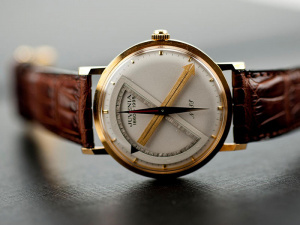Juvenia: Difference between revisions
| Line 10: | Line 10: | ||
==History== | ==History== | ||
[[File:Juvnia.jpg|thumb]] | |||
===1900s=== | |||
Driven by the unceasing desire for development, Juvenia started to create designs for and produce its own range of extra-flat movements in 1908. Aware of the need to make its own calibers in order to become part of the very small circle of major Swiss watchmaking brands, the company began the process of becoming a manufacture. | |||
A boost in technical research allowed Juvenia to present the world's smallest movement to date at the Swiss national exhibition in 1914. It measured 9.5 mm in diameter and 2.5 mm in thickness. In the same year, Juvenia invested in new, modern buildings to help the growth of its industry. | |||
===1920s=== | |||
A hotbed of innovation, Juvenia developed a variety of creations, such as ring watches, pendant watches, table clocks and standing clocks. In the first quarter of the century, their range consisted of a number of significant gift items, such as their very successful table clocks. These were an ideal medium for craftsmen to let their imaginations run wild and create richly decorated pieces. Recognized for their mastery in the art of decorating time, the house's originality was rewarded at the Grand Prix des Arts Décoratifs de Paris in 1925. | |||
==1940 - The Sextant=== | |||
[[File:Juv sextant.jpg|thumb]] | |||
Inspired by the sextant, a navigation tool for measuring the angular distance between two points, Juvenia created an innovatively designed watch where the hands were replaced by a protractor, a ruler and a compass. | |||
===1950s - Trigone=== | |||
[[File:Trigone.jpg|thumb]] | |||
The hands of these models moved like planets in the sky and formed, as the hours went by, different shapes from the star to the pyramid. This playful feature gave the timepiece a fun and non-conventional appearance. Checking the time became a constant and renewable source of pleasure for the wearer. | |||
==Notable Models== | ==Notable Models== | ||
Revision as of 02:11, 14 June 2020
Juvenia
Juvenia was founded in 1860 by Jacques Didisheim-Goldschmidt in Saint-Imier, Switzerland. Shortly after he relocated to La Chaux-de-Fonds, expecting better opportunities. Jacques' son, Bernard, later succeeded his father.
In the 1880s, Juvenia produced one of the first ladies wristwatches. In 1914, Juvenia manufactured, at the time, the smallest movement constructed on a single level.
Juvenia is known for its extraordinary, avant-garde, case designs, unusual time indications and architectural inspiration.
In 1988, Juvenia was acquired by Asia Commercial Holdings Ltd.
History

1900s
Driven by the unceasing desire for development, Juvenia started to create designs for and produce its own range of extra-flat movements in 1908. Aware of the need to make its own calibers in order to become part of the very small circle of major Swiss watchmaking brands, the company began the process of becoming a manufacture. A boost in technical research allowed Juvenia to present the world's smallest movement to date at the Swiss national exhibition in 1914. It measured 9.5 mm in diameter and 2.5 mm in thickness. In the same year, Juvenia invested in new, modern buildings to help the growth of its industry.
1920s
A hotbed of innovation, Juvenia developed a variety of creations, such as ring watches, pendant watches, table clocks and standing clocks. In the first quarter of the century, their range consisted of a number of significant gift items, such as their very successful table clocks. These were an ideal medium for craftsmen to let their imaginations run wild and create richly decorated pieces. Recognized for their mastery in the art of decorating time, the house's originality was rewarded at the Grand Prix des Arts Décoratifs de Paris in 1925.
1940 - The Sextant=

Inspired by the sextant, a navigation tool for measuring the angular distance between two points, Juvenia created an innovatively designed watch where the hands were replaced by a protractor, a ruler and a compass.
1950s - Trigone

The hands of these models moved like planets in the sky and formed, as the hours went by, different shapes from the star to the pyramid. This playful feature gave the timepiece a fun and non-conventional appearance. Checking the time became a constant and renewable source of pleasure for the wearer.
Notable Models
- Mystère - 1940
- Excentrique - Curved case equipped with a quartz movement
- Retro Automatic
- Arithmo - wristwatch, pocket- watch or desk clock (1945)
- Trigone - large triangular hands (1950s)
- Slimatic
- Sextant (1940s)
- Sport
- Macho
- Skeleton
